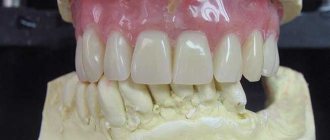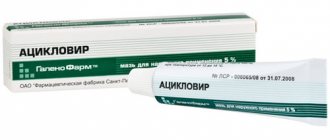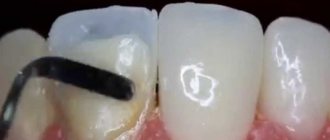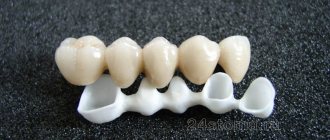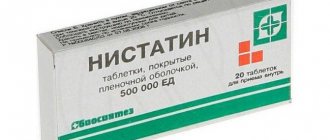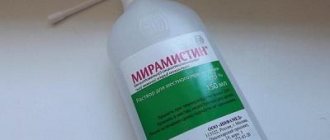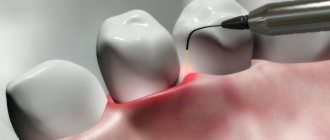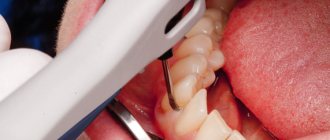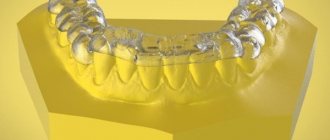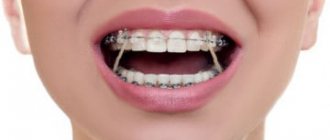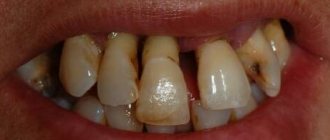Initially, laser dental treatment was used in dentistry only for enamel whitening. In recent years, this procedure has been able to painlessly treat caries, root cysts, dental granulomas and several other, both simple and complex procedures. After reading the article, you will learn about the advantages and disadvantages of the method, the price of the session and how the procedure works.
Laser dental treatment
Laser whitening
Areas of application of laser in dentistry
Laser treatment has become widespread in the following areas:
- Therapeutic dentistry - for the treatment of inflammatory diseases and caries. The laser also stops bleeding during dental procedures.
- Endodontic - root canal treatment, sterilization.
- Aesthetic – teeth whitening.
- Surgical - removal of tumors, correction of gums with hyperplasia, plastic surgery of frenulum. Overhanging gums are removed with a laser before a filling is placed. Preparation for prosthetics will include removal of hypertrophied gums. The surgical laser is used to evaporate, cut, remove and coagulate soft tissue. The technique allows for the treatment of papillomas, hemangiomas, root cysts, fibromas. Gingivoplasty and frenuloplasty are performed to improve the aesthetics of the smile line.
Treatment of caries
Treatment and sterilization of root canals
Teeth whitening
Dental surgery
The use of laser is possible at one of the stages of the following procedures:
| Implantation | |
| Treatment of hyperesthesia (tooth hypersensitivity to hot, cold and sour). | |
| Correction of congenital anomalies (crooked teeth, their incorrect and uneven distribution throughout the jaw, incorrect formation of the jaw shape). | |
| Wedge-shaped defect | Elimination of non-carious pathologies, including wedge-shaped defect. |
Watch a video about the ease of dental procedures thanks to laser technology.
Types of Dental Lasers
The dental laser has long been firmly established in the practice of modern specialists. Laser instruments significantly expand the capabilities of traditional instruments, making the intervention less traumatic and as painless as possible. The areas of use and effectiveness of dental laser systems directly depend on the characteristics of the laser beam, determined by the type of laser.
Argon laser (wavelength 488 nm and 514 nm).
Radiation is well absorbed by melanin and hemoglobin. The 488 nm wavelength is similar to curing lamps. At the same time, the speed and degree of polymerization of light-curing materials is many times higher. In surgery, the argon laser provides excellent hemostasis.
Nd:YAG (neodymium) laser (wavelength 1064 nm).
Radiation is well absorbed in pigmented tissue and worse in water. In the past, it was most popular in dentistry, but has been replaced by the more versatile erbium, diode and combination systems.
He-Ne (helium-neon) laser (wavelength 610–630 nm).
The radiation penetrates well into tissues and has a photostimulating effect. The laser is widely used in physical therapy, and is the only laser that is commercially available.
CO2 (carbon dioxide) laser (wavelength 10600 nm).
Radiation is well absorbed by water and moderately absorbed in hydroxyapatite. The use of this laser on hard tissue is potentially dangerous due to possible overheating of enamel and bone. This laser has excellent surgical properties. Currently, CO2 lasers have given way to more versatile and safe systems.
Diode (semiconductor) laser (wavelength 792–1030 nm).
Radiation is well absorbed in pigmented tissue, has a good hemostatic effect, and has anti-inflammatory and repair-stimulating effects. Used in endodontics, periodontics, for conservative and surgical treatment of diseases of teeth and gums, as well as whitening. Today, the diode laser is the most affordable in terms of price/functionality ratio.
Erbium laser (wavelength 2940 and 2780 nm).
Radiation is excellently absorbed by water and hydroxyapatite. The most promising laser for dentistry. Suitable for working on hard and soft tissues, it does not have the disadvantages of its predecessors and has a wider range of applications, almost completely coinciding with the list of diseases that a dentist has to deal with. Erbium systems have modifications. For example, Er Cr: YSGG (erbium, chromium: ytrium-scandium-gallium garnet) with a wavelength of 2780 nm, which is a patented development of the American company Biolase, allows you to effectively solve problems in almost any area of dentistry with maximum comfort for the patient.
The most common and popular indications for the use of erbium lasers include:
- Preparation of cavities of all classes, treatment of caries.
- Processing (etching) of enamel.
- Sterilization of the root canal, impact on the apical focus of infection.
- Pulpotomy.
- Treatment of periodontal pockets.
- Exposure of implants.
- Gingivotomy and gingivoplasty.
- Frenectomy.
- Treatment of mucosal diseases.
- Reconstructive and granulomatous lesions.
- Operative dentistry.
Share:
Indications for use
Indications for treatment with infrared laser:
| Caries | The laser activates the enzymatic system of the pulp and is used to obtain a cariesstatic effect. The technique is also indicated for the prevention of carious lesions in combination with fluoride-containing drugs. |
| Pulpitis | After preparation of the carious cavity, laser irradiation of the pulp is performed. The procedure is repeated every 24 hours until the desired result is obtained. For chronic pulpitis, up to 5 sessions may be required. |
| Periodontitis | Laser exposure is performed after removing the pus. Irradiation is carried out every day, up to 5 procedures are required in total. Laser therapy is combined with anti-inflammatory therapy. |
| Gingivitis | To accelerate the healing of gingival papillae, eliminate swelling and relieve the inflammatory process. The course of treatment is up to 10 procedures. |
| Periodontitis | Laser therapy is performed after removal of dental plaque. Laser photophoresis stimulates local metabolic processes, improving the nutrition of periodontal tissue. The gums, papillae and periodontal pockets are irradiated. |
| Stomatitis | Laser treatment is combined with drug therapy. Before laser exposure, the mucous membrane is treated with dyes. The course of treatment is 5-10 procedures. |
| Herpes | The laser is applicable at any stage of pathology. The technique promotes tissue regeneration in vesicular rashes. |
| Injuries to the mucous membrane | After antiseptic treatment of wounds, damaged tissues are irradiated. To increase effectiveness, a medicinal product is applied before the procedure. |
Indications and contraindications for the use of lasers
With the help of a laser, it is possible to help even those patients whose treatment with traditional methods of dentistry did not produce noticeable results. First of all, the laser is indicated for children, as well as patients with periodontal diseases, aphthous ulcers, gingival hyperplasia, allergies to standard anesthetics and dental hypersensitivity. However, this method also has contraindications: cancer, acute purulent inflammation in the oral cavity, severe heart disease and the post-infarction period, complex forms of vascular diseases, tuberculosis, severe diabetes mellitus and blood diseases.
Techniques
The table shows the methods and features of the implementation:
| Methodology | Features of the event |
| Contact treatment | The emitter is adjacent to the tissues being treated, the beam penetrates deeply into them, which is necessary for photophoresis and irradiation of the alveolar socket. |
| Contactless | There is a gap of 1 to 8 cm between the source and the irradiator. The laser is used superficially for swelling, inflammation, and pain. |
| Stable method | It is carried out without moving the irradiator, which is in a fixed position throughout the procedure. The laser is applicable when the pathological focus does not exceed 1 cm. |
| Labile | It is performed by moving the emitter across various fields, of which there can be up to 5 in one procedure. In another way, the technique is called scanning, and is indicated for large lesions. During the session, the dentist precisely irradiates the tissue at a speed of 1 cm/second. |
How is laser dental treatment performed?
Laser treatment of caries suppresses the activity of cariogenic bacteria. The technique eliminates the appearance of cracks, chips and loss of fillings.
Stages of caries treatment:
- Examination of the oral cavity, diagnosis, drawing up a treatment plan.
- Local anesthesia.
- Professional hygiene.
- Removal of necrotic tissue.
- Determination of channel length.
- Laser exposure with a gradual decrease in power as it approaches the nerve bundle.
- Sealing of dentinal tubules and application of adhesive to the formed cavity.
- Layer-by-layer filling (usually light-curing composites).
- Final restoration, grinding and polishing.
Treatment of cysts and granulomas is performed without extraction of the causative tooth. The method is only suitable for formations up to 5 mm in size.
Stages of cyst treatment:
- Examination and diagnosis by radiography.
- Tooth cleaning and treatment with antiseptics.
- Unsealing a tooth or opening a cavity.
- Canal expansion and drug treatment.
- Exposure of the cyst to a laser beam to evaporate moisture, which leads to destruction of the capsule.
- Antiseptic treatment and sealing of canals.
- Filling and final polishing.
Comparison of laser treatment of cysts with other types of treatment
Periodontitis is treated with laser only at the initial stage. The emitter allows you to eliminate pathogenic microflora, eliminating the recurrence of the disease.
Stages of periodontitis treatment:
- Visual examination, diagnosis.
- Professional dental hygiene, removal of stone above and below the gums.
- Treatment of periodontal canals with photoditazine gel, which is applied for 10 minutes.
- Treatment of the subgingival part with a beam for 2 minutes near each tooth.
Laser dental treatment for children
Laser therapy in pediatric dentistry is carried out from the age of 7 years.
Laser treatment is used to treat both primary and permanent dentition. Features of laser therapy in pediatric dentistry:
- treatment is effective for caries of primary teeth;
- the procedure does not require pain relief, the child does not feel pain;
- laser allows you to avoid taking antibiotics by stimulating tissue regeneration;
- installations with the ability to adjust power are used.
Laser treatment in pediatric dentistry is completely painless. The non-contact method is more often used, because during the procedure the child does not feel the pressure of the instruments, which reduces fear.
Stages of laser treatment of caries in children:
- Moral preparation of the child for the upcoming procedure.
- Diagnostics.
- Tooth preparation - plaque removal, disinfection.
- Cleaning tissue from necrosis, during which the child feels a slight tingling sensation.
- Tooth isolation and filling.
LiteTouch - dental erbium laser
The laser emitter is located directly in the working tip, which is connected to the device with a flexible electrical cable. Transmission of laser radiation to the object is carried out by a 2-mirror hinge system. This approach combines all the advantages of devices with flexible light guide devices and devices with articulated mirror manipulators:
- The use of a flexible cable ensures easy handling of the tip
- The absence of flexible light guides avoids damage due to bending, as a result: a one-time investment upon purchase and no additional costs
- The mirror system has minimal radiation loss
- Fewer mirrors (two mirrors instead of seven in conventional devices) further reduces radiation losses and reduces the likelihood of misalignments of the optical system
- The compact laser emitter ensures maximum efficiency of optical pumping of the active medium with small dimensions and weight of the tip
LiteTouch™ Er:YAG laser tips
Contra-angle handpiece (with spray)
Contra-angle handpiece (with water)
Handpiece without air cooling. The handpiece provides a continuous stream of water only, without air, to rinse the treatment area instead of a conventional spray. When used in combination with the Gentle Treatment mode, it allows for clean, precise and fine work on the target tissue. In surgery it can be used to avoid emphysema.
Straight tip
Options for attachments (tips) for contra-angle and straight handpieces
The LiteTouch Dental Laser (Er:YAG) with a wavelength of 2940 nm is designed for the modern dental clinic. The compact system with ergonomic design fits easily into any dental office. The only laser in the world without expensive fiber optic elements allows to significantly reduce maintenance costs and operate with minimal output energy losses.
Working hand in hand with dental practitioners, Syneron's Dental has created a truly unique dental laser system. The LiteTouch™ laser delivers state-of-the-art design, superior quality and superior reliability. The handpiece's appearance is no different from a conventional turbine, but it works like a laser, providing all the benefits of laser dentistry:
- Free rotation of the nozzle in the mouth by 360 °
- Flexible cable allows precise work at any angle
- Small tip improves access and visibility within the mouth
- Wide selection of attachments for various procedures
- All attachments and tips are autoclavable
- No energy loss through bulky optical cables improves system reliability and reduces operating time
Graph comparing the power of different types of lasers
LiteTouch™ includes unique software. Various settings allow a wide range of energy and operating frequency. The software provides a large selection of programs for soft and hard tissues. The unique LiteTouch™ system prevents energy loss and allows precise control of pulse duration and frequency.
LiteTouch's Laser-in-Hand piece™ introduces a new concept in laser treatment.
The laser power coming out of the handpiece, unlike conventional lasers, generates a much larger amount of energy, which allows the procedure time to be reduced significantly.
Clinical indications
- Painless, gentle preparation of necrotic cavities without subsequent etching of the enamel
- Treatment and prevention of diseases of the soft tissues of the oral cavity
- Frenulectomy
- Vestibuloplasty
- Gingivoplasty for clinical crown lengthening
- Preparing the gingival sulcus before taking an impression
- Freeing Impacted Teeth
- Biopsy
- Removal of hypertrophied soft tissues
- Removal of fibromas and papillomas
- Opening and draining abscesses
- Treatment and prevention of diseases of hard dental tissues, caries and its complications
- Conditioning of enamel and dentin
- Fissure sealing
- Treatment of hypersensitive teeth and tooth necks
- Treatment of cervical caries and wedge-shaped defect
- Direct pulp sealing
- Treatment and prevention of periodontal diseases
- Closed/open curettage
- Deepitalization
- Gingivectomy and open curettage
- Flap operations
- Placement of implants
- Deployment of implants
- Treatment of peri-implantitis
During pregnancy
Laser treatment can also be performed during pregnancy. This technique is safer than many other surgical procedures.
During this procedure, the woman experiences less stress. The laser can be used to treat caries, periodontitis, and surgical diseases. If possible, the procedure should be performed only in the 2nd trimester of pregnancy.
Important! Any dental procedures during pregnancy are performed only in cases of urgent need, when treatment cannot be postponed until the birth of the child.
The best time for dental procedures during pregnancy is the second trimester
The most favorable period for therapeutic manipulations during gestation is the second trimester . The first months of treatment are extremely undesirable, and can affect the normal formation of organs and systems of the unborn child.
Advantages
- Gentle influence. A laser beam entering an air-water jet gently removes damaged areas. At the same time, it seals the vessels. This reduces the risk of bleeding;
- High accuracy. The laser beam affects only damaged tissue. It does not affect healthy areas;
- Safety. High hygiene is maintained during any manipulation. Pathogenic bacteria do not enter the cavities. All grooves and grooves are securely sealed;
- No pain. There is no room for discomfort in laser dentistry. Patients can do without anesthesia, which is especially important for pregnant women, children, and people suffering from allergies;
- No seams. Even when performing complex surgical laser operations in dentistry, there is no need for sutures. The laser is capable of sealing the edges of wounds;
- No discomfort. The laser does not heat up and does not make noise;
- Versatility. The laser can be used to treat the teeth of young patients, pregnant women and even during breastfeeding.
Advantages and disadvantages
Advantages
- minimal pain relief - it is enough to use a local anesthetic without the need to inject drugs under the mucous membrane;
- disinfection during the procedure, which eliminates infection and minimizes the risk of relapse of the disease;
- safety for groups of patients at increased risk - pregnant women, children, people with pathologies of the cardiovascular system;
- the ability to remove only affected tissues without affecting healthy ones;
- local and atraumatic laser exposure.
Flaws:
- relative high cost;
- presence of contraindications;
- Not every clinic is equipped with expensive equipment.
Price
The price is determined depending on the type of pathology and the degree of tissue damage. The cost is also affected by the type of laser and the region in which the clinic is located. For example, in Moscow and St. Petersburg, you can remove superficial caries with a laser for 2,000 rubles, and in Volgograd, Penza or Nizhny Novgorod, the procedure can cost from 1,000 rubles.
| Treatment of superficial caries | 1000-2000 rub. |
| Deep caries | from 2000 to 11000 rubles per 1 tooth. |
| Whitening one jaw | 8000-13000 rub. |
| Treatment of alveolitis | 1000 rub. |
| Sterilization of the periodontal pocket | 250-500 rub. |
| Treatment of periodontitis | 2000 rub. |
| Removal of a cyst or fibroma | 1500-2000 rub. |
Equipment used
Laser installation Fotona Laser
The laser systems used differ in the power and depth of beam penetration.
In therapeutic dentistry, diode and erbium devices are used.
An argon laser is used for whitening purposes, and a helium-neon laser is used for physiotherapeutic procedures. Treatment of gum pathologies is carried out using a carbon dioxide unit.
Representatives:
- Laser Fotona LightWalker ST-E
- Smart 2940 D Plus;
- Soft-Laser;
- Doctor Smile Pluser Laedd;
- AL-010.
Laser machines can be equipped with one or more types of lasers. In dentistry, devices with wavelengths from 450 to 630 nm are most often used. Each of them comes with disposable tools.
Experience in the clinical use of diode laser at the stages of dental treatment
Introduction. In recent years, in dental practice, along with traditional surgical and therapeutic methods of treatment, fundamentally new tactics for patient management using laser systems have been developed and implemented [2].
The word laser is an acronym for “Light Amplification by Stimulated Emission of Radiation.” The foundations of laser theory were laid by Einstein in 1917 [5]. Surprisingly, it was only 50 years later that these principles were sufficiently understood and the technology could be implemented practically. The first laser using visible light was developed in 1960, using ruby as the laser medium, generating a red beam of intense light. Dentists who studied the effects of ruby laser on tooth enamel found that it caused cracks in the enamel. As a result, it was concluded that lasers have no prospects for use in dentistry. Only in the mid-1980s was there a revival of interest in the use of lasers in dentistry for the treatment of hard dental tissues, and in particular enamel [2; 4; 5].
The main physical process that determines the action of laser devices is the stimulated emission of radiation, formed during the close interaction of a photon with an excited atom at the moment of exact coincidence of the photon energy with the energy of the excited atom (molecule). Ultimately, the atom (molecule) passes from an excited state to a non-excited state, and the excess energy is emitted in the form of a new photon with exactly the same energy, polarization and direction of propagation as that of the primary photon. The simplest principle of operation of a dental laser is to oscillate a beam of light between optical mirrors and lenses, gaining strength with each cycle. When sufficient power is reached, the beam is emitted. This release of energy causes a carefully controlled reaction.
Laser devices with different characteristics are used in dentistry.
Argon laser (wavelength 488 and 514 nm): The radiation is well absorbed by pigment in tissues such as melanin and hemoglobin. The wavelength of 488 nm is the same as in curing lamps. At the same time, the speed and degree of polymerization of light-curing materials by laser far exceeds similar indicators when using conventional lamps. When using an argon laser in surgery, excellent hemostasis is achieved.
Diode laser (semiconductor, wavelength 792–1030 nm): radiation is well absorbed in pigmented tissue, has a good hemostatic effect, has anti-inflammatory and repair-stimulating effects. The radiation is delivered through a flexible quartz-polymer light guide, which simplifies the surgeon’s work in hard-to-reach areas. The laser device has compact dimensions and is easy to use and maintain. At the moment, this is the most affordable laser device in terms of price/functionality ratio.
Nd:YAG laser (neodymium, wavelength 1064 nm): radiation is well absorbed in pigmented tissue and less well absorbed in water. In the past it was most common in dentistry. Can operate in pulse and continuous modes. Radiation is delivered via a flexible light guide.
He-Ne laser (helium-neon, wavelength 610–630 nm): its radiation penetrates well into tissues and has a photostimulating effect, as a result of which it is used in physiotherapy. These lasers are the only ones that are commercially available and can be used by patients themselves.
CO2 laser (carbon dioxide, wavelength 10600 nm) has good absorption in water and average absorption in hydroxyapatite. Its use on hard tissue is potentially dangerous due to possible overheating of enamel and bone. This laser has good surgical properties, but there is a problem with delivering radiation to tissues. Currently, CO2 systems are gradually giving way to other lasers in surgery.
Erbium laser (wavelength 2940 and 2780 nm): its radiation is well absorbed by water and hydroxyapatite. The most promising laser is in dentistry; it can be used to work on hard dental tissues. Radiation is delivered via a flexible light guide.
Today, laser technologies have become widespread in various areas of dentistry, which is due to intra- and postoperative advantages: absence of bleeding (dry surgical field) and postoperative pain, rough scars, reduction in the duration of surgery and the postoperative period [2; 4].
In addition, the use of new generation laser technologies meets modern requirements of insurance medicine [3].
The purpose of the work is to evaluate the possibilities of working with a diode laser at the stages of dental treatment.
Material and methods: to achieve the goal, available literature sources on this topic were analyzed, and the clinical performance of a diode laser was assessed for various dental procedures.
Results and discussions: during the work, the effect of a diode laser on periodontal tissue and the oral mucosa was studied, the optimal parameters and mode of exposure to radiation were determined for each type of dental intervention, taking into account the individual characteristics of the patient.
Based on data obtained by domestic and foreign authors [1; 5], it was found that laser therapy reduces the induction of pro- and anti-inflammatory cytokines, inhibits the activation of the proteolytic system and the formation of reactive oxygen species, enhances the synthesis of proteins of nonspecific immune defense and ensures the restoration of membranes of damaged cells (Fig. 1).
